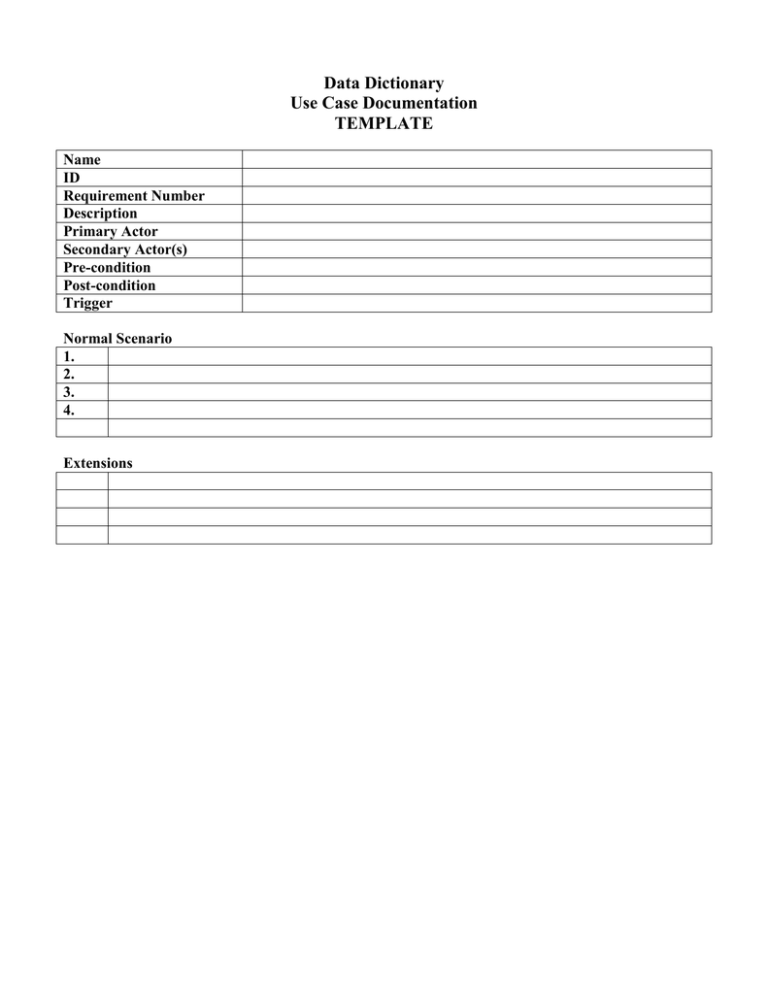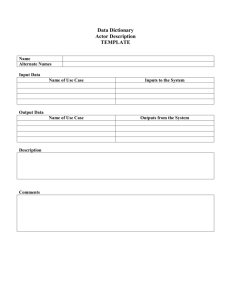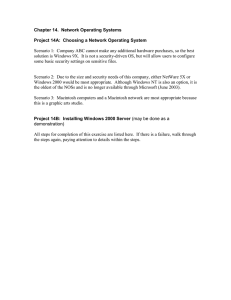Data Dictionary Use Case Documentation TEMPLATE
advertisement

Data Dictionary Use Case Documentation TEMPLATE Name ID Requirement Number Description Primary Actor Secondary Actor(s) Pre-condition Post-condition Trigger Normal Scenario 1. 2. 3. 4. Extensions Data Dictionary Use Case Documentation INSTRUCTIONS Name - ID - Name of the use case EXACTLY as it appears on the use case diagram. Remember the name should be a verb or verb phrase with the first letter of each word in the name capitalized. The integer value assigned to the use case. Requirement Number - The number of the functional requirement in section III of the SRS that this use case satisfies. This section provides traceability between the functional requirements and the individual use cases. Description - Brief description of the general purpose of this use case. Primary Actor – List the person or thing that starts or triggers the execution of the use case. Secondary Actor(s) – List other persons or things who have an interest in the use case. Pre-conditions – The necessary conditions that have to be met before the use case can be performed. When writing a precondition, you are making a simple assertion statement about the current state of the world when this use case opens. The mistake in writing preconditions is writing something that is often, but not always, true. Example of a pre-condition: A customer has been validated. Post-conditions – The state of the system after the use case is performed. These statements state what interests are satisfied after a successful conclusion of the use case. For example, a value delivered to the actor. Trigger - Specifies the event that gets the use case started. It precedes the first step of the normal scenario. Examples: Customer inserts card. Customer calls in complaint Normal Scenario – Each path of execution through the use case is defined as a scenario. For every use case you will define a normal scenario which is the path that a user is mostly likely to follow. This normal scenario does not contain exceptions or alternative paths of execution. This normal scenario cannot be executed unless the pre-conditions are satisfied and needs to satisfy all requirements of post-conditions. Instructions for formatting this normal scenario are provided in the lecture on use case descriptions. The steps are numbered sequentially starting at 1. Extensions - Extensions can be failures, exceptions, or alternative ways of accomplishing the primary scenario’s goal. Instructions for formatting extensions are provided in the lecture on use case descriptions. Grading Criteria Data Dictionary – ACTOR and USE CASE Descriptions 1. Lateness of deliverable: -- as on grading criteria (max of 50 points 1 day late 20 points 2 days late 40 points 3 days late 80 points After 3 days late a zero grade is recorded. 2. Correctness (80 points total): a. Actor (20 points total) (2 points per infraction) i. Name does not match use case diagram ii. Actors missing or incorrect iii. Obvious alternate names missing -0 poiints iv. Description missing, incomplete, incorrect, or ambiguous. b. Use Case (60 points total) (3 points per infraction) i. Name does not match use case diagram ii. ID does not match use case diagram iii. Requirement number does not match functional requirement in Section III of the SRS. iv. Description missing, incomplete, incorrect, or ambiguous. v. Pre-condition missing, incomplete, incorrect, or ambiguous. vi. Post-condition - missing, incomplete, incorrect, or ambiguous. vii. Trigger - missing, incomplete, incorrect, or ambiguous. viii. Normal scenario - missing, incomplete, incorrect, or ambiguous. 1. Scenario steps out of order 2. An extension included in the normal scenario. 3. Not underlying reused use cases. 4. Steps written too granular (keystroke level) 5. Steps written too broad (for example, rent video) 6. Use of proper phrasing (for example, check whether vs. validate) ix. Extensions – missing, incomplete, incorrect, or ambiguous. 1. Extension steps out of order 2. Extension numbering incorrect 3. A normal scenario step included in the extension. 4. Not underlying reused use cases. 5. Extension written too granular (keystroke level) 6. Extension written too broad (for example, rent video) 3. Format(20 points total): a. Not written in required format as provided in instructions – 1 point per occurrence i. Not in the table format provided. ii. Normal scenario steps not written in the specified format (for example, subjectverb-direct object) iii. Extensions not written in the specified format (for example, missing colon) iv. Misspelled words – ½ point for each



